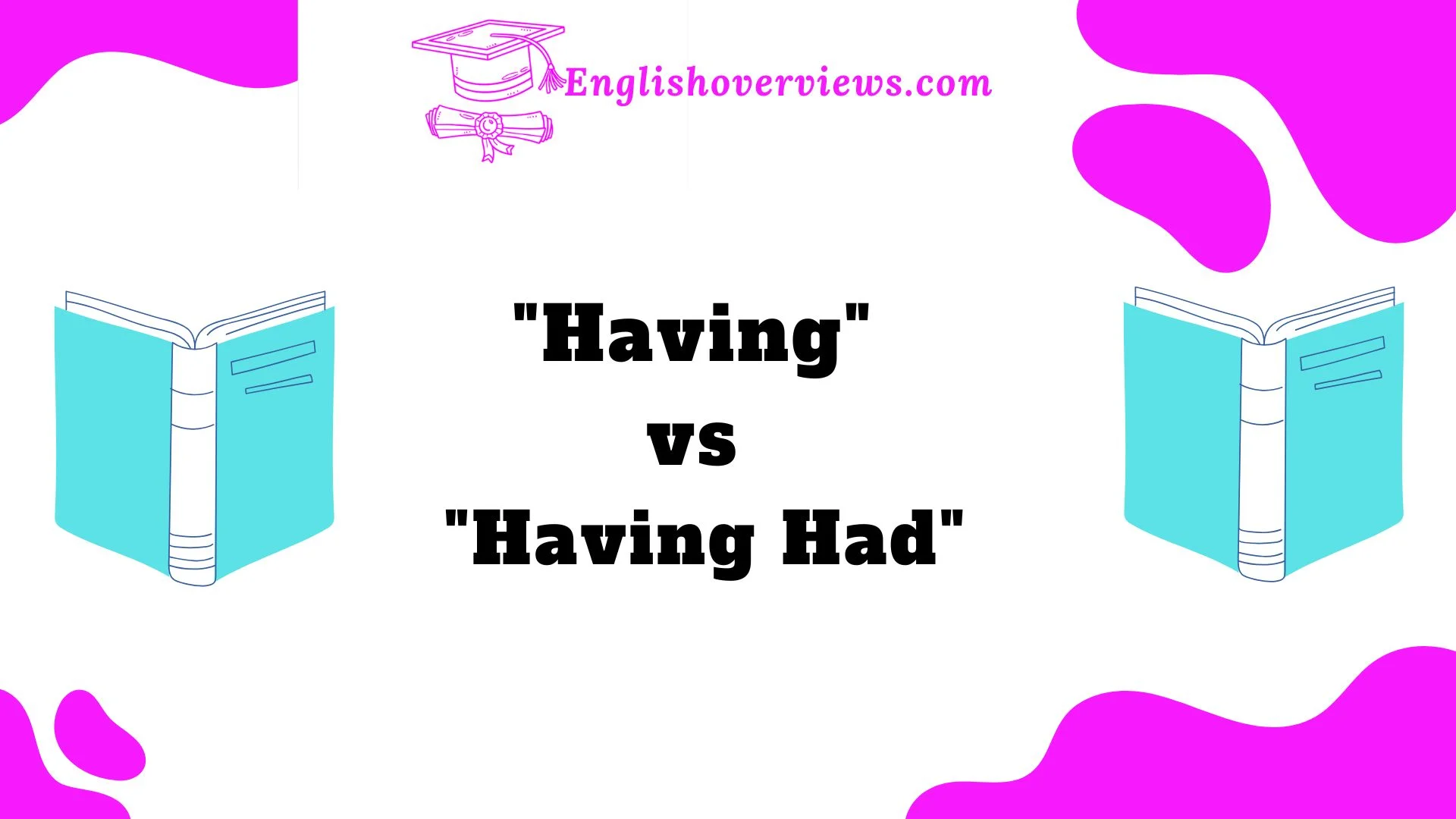Have you ever stumbled across the phrases “having” and “having had” and wondered how to use them correctly? You’re not alone! These grammar constructions might look similar, but they serve very different purposes. Knowing how and when to use them can add precision and depth to your writing, whether you’re crafting an essay, sending a business email, or just brushing up on your English skills.
This guide will break everything down for you, from definitions and examples to advanced grammar insights. You’ll walk away with a clear understanding of these phrases and practical tips to master them in everyday and formal contexts.
So, let’s dive right in and uncover the nuances of “having” vs. “having had.”
What is “Having”?
The word “having” is a present participle, meaning it’s a verb form used to describe ongoing actions, states, or functions. Think of it as a versatile grammar tool that can act as a noun, adjective, or part of a continuous tense.
How “Having” Works in Sentences
Here are the three main ways “having” is used:
- As a Gerund (Noun Form)
- When “having” functions as a gerund, it represents an action or a state.
- Example: “Having patience is a valuable trait.”
- Here, “having patience” is treated as the subject of the sentence.
- As a Present Participle (Adjective Form)
- “Having” can describe or modify a subject by linking it to an action.
- Example: “The woman, having lost her wallet, appeared distressed.”
- The phrase “having lost her wallet” gives additional context about the woman.
- In Continuous Tenses
- “Having” frequently appears in present continuous or progressive forms.
- Example: “I’m having dinner with my family.”
- Here, “having” indicates an ongoing action.
Common Examples of “Having” in Use
- “Having a positive attitude can change your perspective.”
- “I enjoy having conversations with people from different cultures.”
- “Having too many options can be overwhelming.”
What is “Having Had”?
The phrase “having had” is a perfect participle, which combines the present participle “having” with the past participle “had.” This form is used to express an action or state that was completed before another action or point in time.
How “Having Had” Works in Sentences
- To Show Sequence
- “Having had” indicates that one action was completed before the next began.
- Example: “Having had coffee, she felt more awake.”
- The coffee-drinking occurred before feeling awake.
- To Add Formality
- It is often used in academic or professional contexts to emphasize a completed action.
- Example: “Having had previous experience in marketing, he excelled in his new role.”
- In Complex Sentences
- “Having had” works well in sentences requiring nuanced time relationships.
- Example: “Having had a difficult week, he decided to take a break over the weekend.”
Common Examples of “Having Had” in Use
- “Having had prior knowledge of the subject, she participated confidently in the discussion.”
- “The team, having had a successful year, celebrated their achievements.”
- “Having had enough practice, he felt ready for the exam.”
The Key Differences Between “Having” and “Having Had”
It’s easy to confuse “having” and “having had,” but their usage depends on timing and context. Here’s a quick breakdown:
| Aspect | Having | Having Had |
| Timeframe | Refers to current or simultaneous actions. | Refers to an action completed in the past. |
| Complexity | Simple and informal in tone. | More formal and often used for emphasis. |
| Example | “Having a great time is important.” | “Having had a great time, we left the party.” |
| Formality | Everyday speech or writing. | Academic, professional, or formal contexts. |
Quick Tips to Remember
- Use “having” when talking about actions or states happening now or at the same time as another event.
- Use “having had” to emphasize actions that were completed before another event occurred.
Practical Scenarios Where “Having Had” is Essential
1. Academic Writing
In essays or research papers, “having had” helps establish sequence and adds formality.
- Example: “Having had access to primary data, the researchers were able to draw accurate conclusions.”
- This phrasing highlights the completion of accessing data before drawing conclusions.
2. Professional Communication
In business reports or formal correspondence, “having had” conveys professionalism.
- Example: “Having had significant experience in project management, she was an ideal candidate for the role.”
3. Cause-Effect Relationships
When showing how one action leads to another, “having had” is the perfect choice.
- Example: “Having had limited resources, the team relied on creativity to meet their goals.”
Examples of “Having” vs. “Having Had”
Everyday Contexts
- “Having breakfast, I read the newspaper.”
- “Having had breakfast, I was ready to start the day.”
Formal Writing
- “Having the necessary documents will expedite the process.”
- “Having had the necessary documents, the application was approved quickly.”
Professional Communication
- “Having technical skills is important in this field.”
- “Having had years of technical training, he was promoted to team lead.”
Case Study: Misusing “Having” and “Having Had”
Let’s analyze a real-world example:
Scenario: Job Application
- Incorrect: “Having experience, I applied for the job confidently.”
- This sentence lacks clarity about the timeframe of the experience.
- Correct: “Having had experience in similar roles, I applied for the job confidently.”
- The revised version clarifies that the experience was gained before applying.
Advanced Insights: Understanding the Perfect Participle
The perfect participle is formed by combining “having” with a past participle (e.g., “had”). It adds depth to your writing by:
- Clarifying Time Relationships
- Example: “Having had prior knowledge, I approached the problem differently.”
- Avoiding Redundancy
- Instead of writing: “I had completed the task before moving on,”
- Use: “Having had completed the task, I moved on.”
- Instead of writing: “I had completed the task before moving on,”
Tips for Mastering “Having” vs. “Having Had”
- Start with Simple Sentences: Practice distinguishing between the two with clear, short examples.
- Use Context Clues: Think about the timeframe. Is the action happening now (use “having”) or was it completed earlier (use “having had”)?
- Leverage Tools: Apps like Grammarly or ProWritingAid can help identify errors in grammar.
- Read Widely: Exposure to formal writing can reinforce proper usage.
- Create Your Own Examples: Write sentences in different contexts to solidify your understanding.
FAQs
1. Can I use “having had” in informal speech?
You can, but it may sound overly formal. Use simpler alternatives in casual settings.
2. Is “having had” outdated?
No, it’s still widely used in academic and professional contexts.
3. Can “having” and “having had” be used interchangeably?
No, they have distinct meanings and should be used based on the timeframe.
4. How can I improve my understanding of participles?
Practice regularly, read formal writing, and use grammar guides for reference.
5. Why is “having had” important in writing?
It adds clarity, formality, and precision, especially in complex or professional contexts.
Conclusion
Understanding the nuances of “having” and “having had” empowers you to write with greater clarity and confidence. While “having” works for current or ongoing actions, “having had” emphasizes actions completed before another point in time. By mastering these distinctions, you’ll enhance your communication skills across both casual and formal contexts.
Keep practicing, and you’ll soon find these forms becoming second nature. Whether it’s writing a professional email or crafting an academic paper, you’ve got this!

English Overviews is a resourceful website dedicated to providing valuable content related to grammar and vocabulary. Muhammad Haroon has made notable contributions, sharing insights on various subjects, including WordPress themes and plugins. The primary goal of the site is to help users improve their English language skills effectively.











